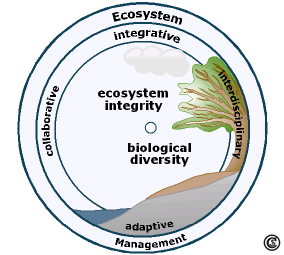Glossary
E
Ecosystem management
Ecosystem management is an integrative, interdisciplinary, adaptive and collaborative approach to policymaking, planning and management that focuses on the long-term health of an ecosystem. Priority is given to the functioning and stability of the entire ecosystem rather than its specific parts.
The goal of ecosystem management is to sustain or restore ecosystem integrity and biological diversity at all spatial and temporal scales. This is to be attained through scientific understanding of the components and processes of the ecosystem and collaborative decision-making.
Ecosystem management is grounded in the understanding that human activity and physical components are inextricably linked within an ecosystem (Ewert et al. 2004; Randolph 2003, cited in: Butler 2003).
G
Geospheres
In general, the geosphere is considered to comprise the entire solid Earth and its atmosphere. The Earth's solid body is divided into the interior and exterior core, the mantle and the crust. The thin layer at the top of the crust is called the pedosphere. A high proportion of the earth is covered by water. This realm is termed the hydrosphere. Biotic substances form the biosphere (Brunotte et al. 2002).
The term geosphere is used here in a variant understanding. Geosphere is used for all the different spheres building up the geosphere (see figure). However, only one section of the geosphere is considered. Besides the physical spheres the human sphere is also included.
I
Infiltration rate
The infiltration rate of a soil is the velocity at which water can seep into the soil. It is commonly measured by the depth (in mm) of the water layer that the soil can absorb in an hour. An infiltration rate of 15 mm/hour means that a water layer of 15 mm on the surface of the soil, will take one hour to infiltrate into the soil (Tidemann 1996).
Infiltration is the process when rain or irrigation water which is supplied to a field seeps into a soil (Tidemann 1996).
Determining factors
The infiltration rate depends on different factors. Soil texture is an important determining factor. In a sandy soil, the infiltration rate is higher than in a silty soil, for example. Further factors influencing the infiltration rate are
- soil structure;
- humus content;
- soil moisture;
- soil depth;
- soil surface roughness.
Values for infiltration rates
The range of possible values for infiltration rates are classified by Tidemann (1996) as follows
- low infiltration rate: < 15 mm / hour;
- medium infiltration rate: 15 to 50 mm / hour;
- high infiltration rate: > 50 mm / hour.
